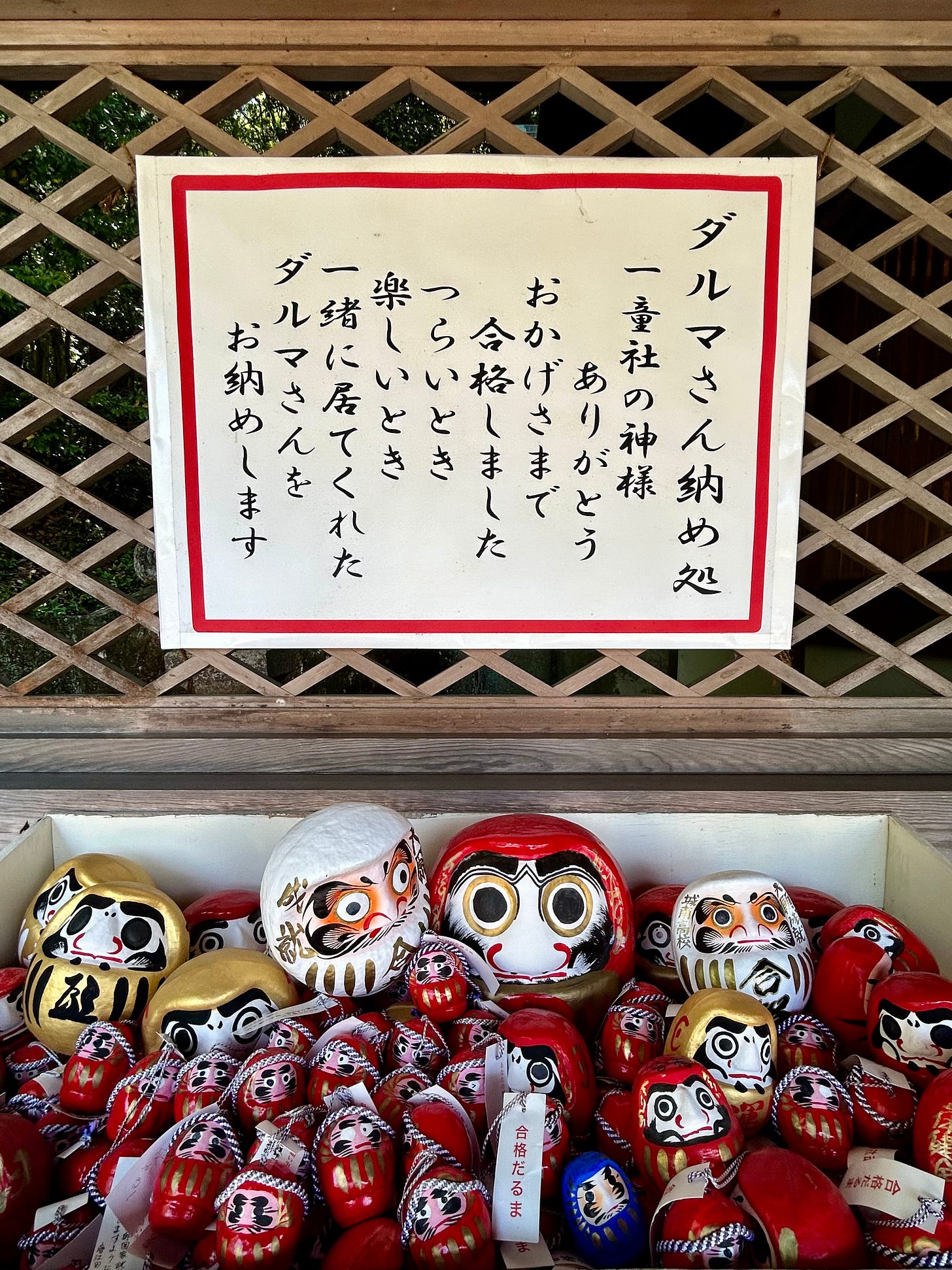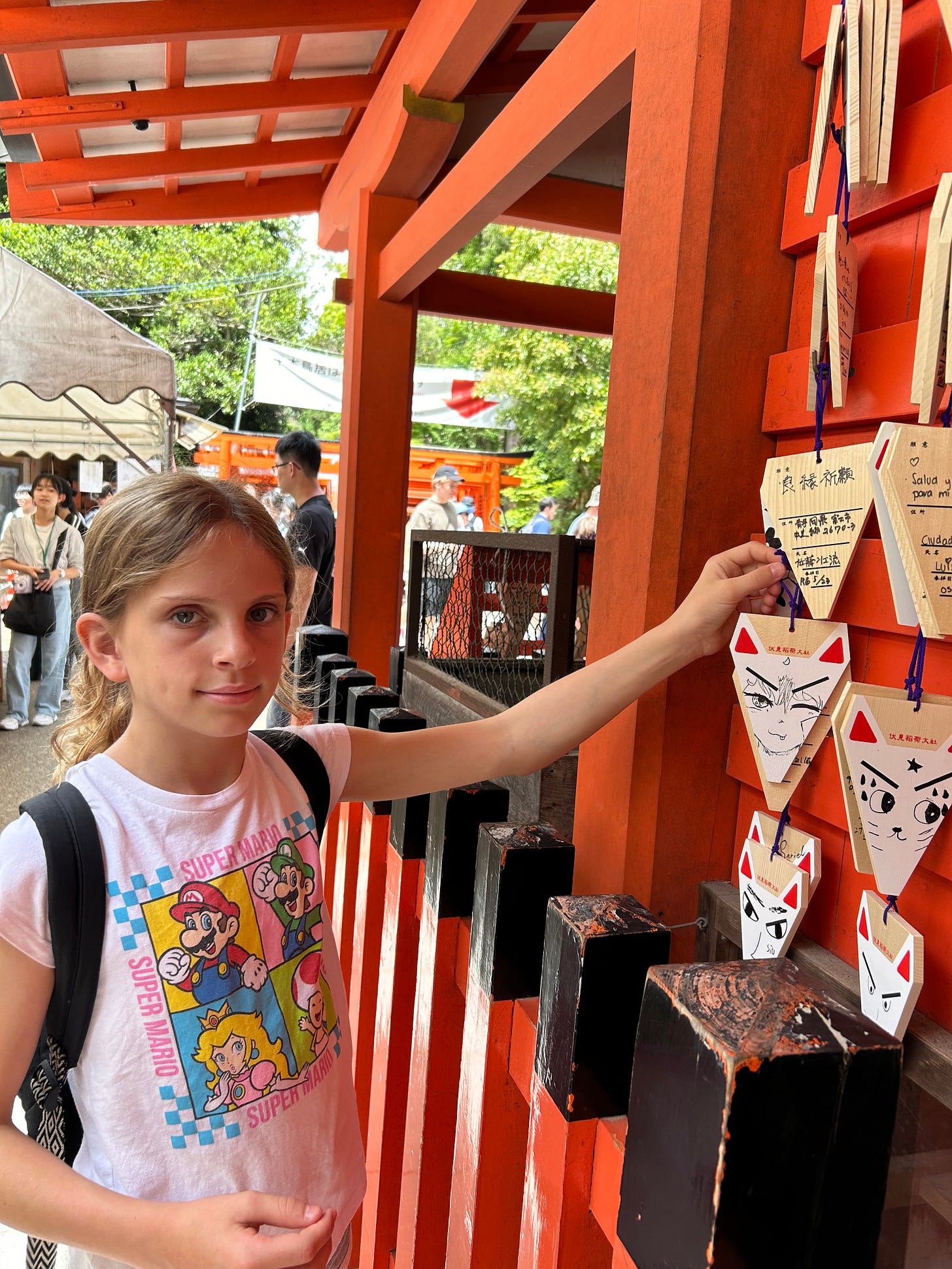Japan was always a mysterious place in my mind until recently when I took the 11 ½ hour flight with my family to experience its wonders first hand. This trip was a fantastic opportunity to open our world up to something completely unknown to us, so we jumped at the chance when we had it. The impact of this journey will be unveiled in bits and pieces over time, like the way the beautiful country presented itself in surprising moments by bullet train, ferry, bike, and pavement. I simply cannot impart all the impressions Japan has left on me in this one newsletter, but I can tell you about the country’s shrines and temples, and one powerful fire ritual’s impact on my thinking about my nearly 10-year odyssey with chronic pain.
Shintoism and Buddhism are foundational religions in Japan. In very simple terms, Shintoism (the older of the two) is grounded in a belief in the existence of spirits in living things and inanimate objects while Buddhism emphasizes the hope of achieving enlightenment. These religions in many ways complement each other and as a result many Japanese people participate in both. Shrines represent the Shinto religion and temples, Buddhism. Each has unique physical elements and religious practices which you can read more about HERE.
The country is covered with these structures (nearly 160,000), from tiny shrines in village yards and on the narrow streets of Tokyo and Kyoto, to massive temples with entire communities and parks built around them. When visiting a shrine, it is custom to purify oneself through hand washing, then pray and leave an offering. Shrines often invite you to write down a wish on an “Ema Board” to be burned later, to release it from the writer. In these sacred Japanese places, we took the opportunity to honor the ancient traditions of a people we have little history with. I left a note on an Ema Board at the Meiji Shrine in Tokyo to send good wishes for a dear friend who has suffered great loss this past year. My daughter wrote a secret note at Kyoto’s famous Fushimi Inari Shrine for whose contents I will never know. At shrines and temples, we tossed yen coins and bowed in the traditional way, paying our respects to the religious ways of the Japanese people and took to quietly roaming these holy grounds that have been visited for centuries.
While I paint a charming and calm picture of these visits, the Fukagawa Fudo Temple fire ritual was neither quiet nor peaceful, and provided an intense experience I will not soon forget. We read about this temple on a blog and I was captivated immediately with the idea of visiting this off the beaten path place which promised less tourists and an authentic experience. After rushing through the hurried crowds of the well-known Tsukiji Outer Market for a quick lunch of sushi and yakatori (grilled meats), we hopped a taxi for the short ride to experience this ritual first-hand.
The fire ritual takes place several times a day behind the temple ground’s concrete walls within the main temple structure. When arriving, we slipped off our shoes and entered to find perhaps 50 people quietly sitting in rows on hard wooden benches, waiting for the ritual to begin. The fire ritual is intended to eliminate negative thoughts, wants, and energies by giving power to Fudōmyō-ō, the Buddhist god of justice. The fire is said to build up this god’s power and in doing so, burn the issues that stand in the way of enlightenment. I certainly could relate to the need to eliminate negative thoughts, especially as related to my chronic pain journey over the last 10 years, so I found my bench seat and decided I would see if this ritual could serve me in some way too.
I step back into the experience and share it here:
It is so quiet as I step into the large room with stadium-like seating and a gilded alter. I can hear my own breath. Japanese people of all ages are present and ready to experience Fudōmyō-ō’s power. Monks gather in front of the alter taking their designated places on small stools, many playing handheld drums. The monks begin to quietly chant, and a conch shell is blown, calling the worshippers to attention. As the chanting grows stronger, the head priest, seated at the fire circle begins to burn small strips of wood. As the crackling fire grows larger, climbing above his head, the chants strengthen. One monk takes a strong firm stance in front of a massive drum larger than a sumo wrestler. He begins striking the drum loudly and the sound reverberates in the room and I can feel its power thumping in my chest.
As the powerful sounds and smells envelope my senses, I think about the ritual’s intention – to rid oneself of what burdens them. This brings me to consider Pain, a character in my manuscript. I close my eyes and observe Pain’s presence. Her twinge in my back, through my neck, and down my arm sting as I tried to remain erect in the uncomfortable seat with no backing for rest. With each pound of the drum and the rising temperature and expanding smoke I focus on her intently. She is here as always and I am beyond angry. As the chants swirl in my head, I consider my resentment towards Pain. Like the fire ritual burning what stands in the way of achieving true enlightenment, in this moment, could I consider that like the god of justice’s power to burn a path’s obstacle, I have power too? I focus on the idea of power, power to decide how I respond to Pain - either allowing it to dominate, or using my own fire, clear any obstacles despite her. I am in a dizzying state at this point due to the drums, chanting, heat, and smoke but it some ways I find more clarity than I have in some time.
Slowly the ceremony winds down, and people begin to rise from their seats and head to the alter. One by one they hand their purses or bags to the monk standing behind the fire and he passes their item over it. I do not fully understand the purpose of this act in the moment and choose not to participate. Later I come to see that the physical act of passing one’s belongings over the fire was a symbolic way to do what musician Elle King termed “The Let Go” (in her song by the same name). Letting go of what holds us back, of what keeps us from true happiness, of what lets us live to our true potential.
While I symbolically tried to let go of Pain in that temple in Tokyo that day, I cannot say she is gone. She is here every day but the fire’s burn and the act of sitting with Pain and my anger towards her allowed me to take one more step towards a full and eventual let go.
We exited the temple and slipped our shoes back on, ready for our next adventure in Japan. My kids excitedly talked about our plans for the following day, which included a visit to Team Lab’s immersive museum which proved to be a trip highlight for them. While I hurriedly followed them as we jaunted for the subway, Pain whispered to me, “I am still here you know”. Yes, I do know, Pain, but we’re on a new path. I’ll lead the way.
What is an example of how you have used your power to activate change or embrace “the let go”?










Love your power move of a last line “ Yes, I do know, Pain, but we’re on a new path. I’ll lead the way.’” Good mental shift!!! Maybe one day Pain will just be pain.
A life changing, energetically enhancing and shifting experience by the sounds of it 😍
I cannot wait to find out where this new path takes you!!
Like yourself, I have been on my own decades long journey with pain. So severe when it first began back in 1998 that I thought I was dying.
I didn’t “wake up” to the severity of it until 2018 (I learnt to numb out and ignore it for the 20 years before that).
It’s since been one hell of a journey since then and I’ve recently been guided onto a new path; one of ‘ease and release’.
Interesting to see how tricky this one is to stay on! But I’m getting there.
Your post ignites a reference to 2 blogs I have written that I’d like to share (with no expectation or obligation to read of course).
One detailing a break up letter I wrote to pain and the other on my choice of path.
https://warriorwithin.substack.com/p/a-break-up-letter-to-pain
https://warriorwithin.substack.com/p/choose-your-path?utm_source=publication-search